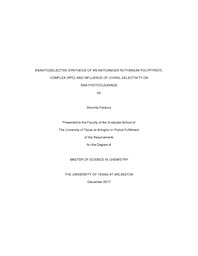
ATTENTION: The works hosted here are being migrated to a new repository that will consolidate resources, improve discoverability, and better show UTA's research impact on the global community. We will update authors as the migration progresses. Please see MavMatrix for more information.
Show simple item record
| dc.contributor.advisor | MacDonnell, Frederick M. | |
| dc.creator | Ferdous, Shomita | |
| dc.date.accessioned | 2018-02-15T20:48:38Z | |
| dc.date.available | 2018-02-15T20:48:38Z | |
| dc.date.created | 2017-12 | |
| dc.date.issued | 2017-12-08 | |
| dc.date.submitted | December 2017 | |
| dc.identifier.uri | http://hdl.handle.net/10106/27191 | |
| dc.description.abstract | Ruthenium polypyridyl complexes (RPCs) represent a promising therapeiutic class of drugs for transition-metal based anticancer drug development. The complex [(phen)2Ru(tatpp)Ru(phen)2] (44+) is a RPC which has shown success in both cell free and cellular assay. Unlike many other RPCs, 44+ can selectively kill malignant cells without light irradiation from external sources. This binuclear complex 44+ is a DNA intercalator containing redox-active ligand tatpp (9,11,20,22-Tetraaza tetrapyrido[3,2-a:2'3'-c:3'',2''- 1:2''',3''']-pentacene) which cleaves DNA in presence of a mild reducing agent, i.e. glutathione (GSH).1,2,3 The cellular assay (MTT assay) with different types of malignant cells has also established this as an equally potent cytotoxic agent both under normoxic and hypoxic conditions.1 According to the recent report, the cytotoxicity of 44+ can also be increased by tuning the polypyridyl ligands and making them more lipophilic (IC50 ~11 became ~2.1 in breast cancer cell line MCF7 after increasing lipophilicity).2 The enantiopurity of this RPC also has been found to influence the cytotoxicity potential (IC50 ~9.5 μM for ΔΔ-44+, ~16.7 μM for ΛΛ-44+ in non-small cell lung carcinoma cell lines, H358 and H226) and maximum tolerable dose in mice (100 mg/kg mouse for ΔΔ-44+, 66 mg/kg mouse for ΛΛ-44+).3 However, synthesis of enantiopure 44+ has been very challenging because of the multiple intermediate steps and over-all low yield.
This thesis represents a simplified synthetic approach for enantioselective 44+ with greater yield. RPCs have shown promise as photosensitizer in anticancer photodynamic therapy (PDT).26 This thesis also shows that 44+ is capable of inducing photocleavage when irradiated with blue light (470 nm) without the presence of reducing agent GSH. The stereo-selectivity also influences the rate of photocleavage reaction by inducing ~64%, ~57% and ~33% cleavage for supercoiled plasmid pUC18 DNA to produce circular plasmid DNA. Three types of radical ion scavengers including hydroxyl radical scavenger (mannitol, ethanol, sodium pyruvate), singlet oxygen scavenger (sodium azide) and metal or carbon-based radical scavenger (TEMPO) were used to indicate the radical species for photocleavage. Only TEMPO caused significant quenching in plasmid cleavage reaction which indicates that the responsible radical species is a metal or carbon-based radical. Based on the results a mechanism was proposed which says a metal based radical with highly oxidizing triplet excited state might be the cause of DNA strand secession by 44+. | |
| dc.format.mimetype | application/pdf | |
| dc.language.iso | en_US | |
| dc.subject | Ruthenium polypyridyl complex | |
| dc.subject | Anticancer | |
| dc.subject | Enantiopure | |
| dc.subject | DNA-Photocleavage | |
| dc.title | ENANTIOSELECTIVE SYNTHESIS OF AN ANTICANCER RUTHENIUM POLYPYRIDYL COMPLEX (RPC) AND INFLUENCE OF CHIRAL SELECTIVITY ON DNA PHOTOCLEAVAGE | |
| dc.type | Thesis | |
| dc.degree.department | Chemistry and Biochemistry | |
| dc.degree.name | Master of Science in Chemistry | |
| dc.date.updated | 2018-02-15T20:50:45Z | |
| thesis.degree.department | Chemistry and Biochemistry | |
| thesis.degree.grantor | The University of Texas at Arlington | |
| thesis.degree.level | Masters | |
| thesis.degree.name | Master of Science in Chemistry | |
| dc.type.material | text | |
Files in this item
- Name:
- FERDOUS-THESIS-2017.pdf
- Size:
- 2.397Mb
- Format:
- PDF
This item appears in the following Collection(s)
Show simple item record


